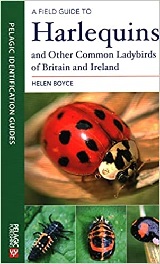A Field Guide to Harlequins and Other Common Ladybirds of Britain and Ireland

Helen Boyce
Pelagic Publishing, £19.99 (paperback)
As their name suggests, harlequin ladybirds are brightly coloured and have varied patterning, which can make them confusing to identify. Helen Boyce has made this task much easier by providing a detailed guide to distinguish harlequin ladybirds from other ladybird species, throughout their life stages. There are sections on the general characteristics of ladybirds, alongside information on the egg, larval and pupal stages of their lifecycle. The history of the arrival of the harlequin ladybird in Britain and Ireland is explored and information is provided on where and when to them. Comparisons for each stage of their life cycle are superbly illustrated with full colour photographs throughout. The comparisons are clearly explained and can be easily understood by amateur naturalists and professional entomologist alike.
More than half of the book concentrates on the adult form of these insects and there are short sections covering the differences in appearance of the newly emerged adult, overwintering strategies, protective adaptations and parasites as well as food supply. The adult form of the Harlequin ladybird is particularly variable in appearance and detailed information is provided in relation to just about every feature, including colour forms, shoulder spots, ‘angel wings’ and size. There is a useful identification key provided that incorporates the various identification features discussed in other sections of the book. Full colour photographs are also provided of the larval and adult stages of 26 other conspicuous ladybird species of Britain and Ireland, with brief identification features of the adult forms.
Finally, there is a useful glossary and information on how to record sightings of ladybirds with the UK ladybird survey. Overall this is an extremely useful identification guide for a particularly variable species and an undoubted aid that can be of value in both the field and the laboratory.
Dr Alan Woollhead


